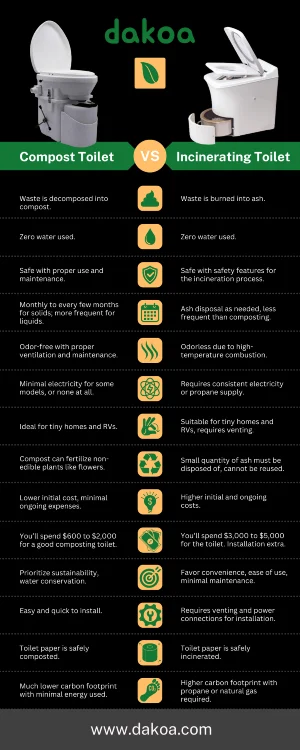Discover the world of alternative toilets: composting toilets and incinerating toilets, key players in eco-friendly waste management where traditional plumbing falls short. These systems aren’t just innovative; they offer a green solution to the limitations of conventional toilets, saving gallons of water and providing flexibility for tiny homes, RVs, and off-grid living.
As we explore the benefits of water conservation, reduced maintenance, and sustainability, this guide delves into the nitty-gritty of composting versus incinerating toilets. It’s not just about managing waste; it’s about choosing a path that aligns with your environmental values and lifestyle needs.
Whether you’re navigating the compact space of a tiny home or the remote setup of an off-grid cabin, join us in uncovering the perfect fit for your sustainable living journey.
Why Consider an Alternative Toilet?
In today’s push for eco-friendly living, the search for waterless toilet systems like composting and incinerating toilets is gaining momentum. These alternatives offer sustainable solutions far beyond what traditional toilets can provide, making them ideal for the eco-conscious individual. Whether you’re living in a tiny house, traveling in an RV, or setting up a secluded cabin, these toilets are transforming waste management for the better.
The move away from conventional toilets, known for their high water consumption, highlights a broader shift towards sustainability and reducing environmental impact. For those in areas facing water scarcity or looking to cut ties with traditional septic systems, the benefits of composting and incinerating toilets shine even brighter.
- Composting Toilets: By turning human waste into compost, these units not only save water but also contribute to soil health, supporting a cycle of reuse and sustainability.
- Incinerating Toilets: These units incinerate solid waste and liquid waste at high temperatures, producing a small amount of sterile ash. This process minimizes maintenance and eliminates the need for a water supply or complex waste management system.
Choosing one of these waterless toilets means you’re not just conserving water; you’re adopting a waste management practice that’s in harmony with the environment. It’s a significant step toward sustainable living, perfect for those maximizing tiny home spaces, embracing the RV lifestyle, or incorporating eco-friendly practices in suburban homes.
This trend toward alternative toilets reflects a growing commitment to sustainability, focusing not only on water conservation but also on creating a balanced relationship with our environment. Whether it’s a composting toilet system in a tiny home or an electric incinerating toilet in an off-grid setup, these options are paving the way for a greener future, offering practical, environmentally friendly solutions for modern living.
Understanding Composting Toilets
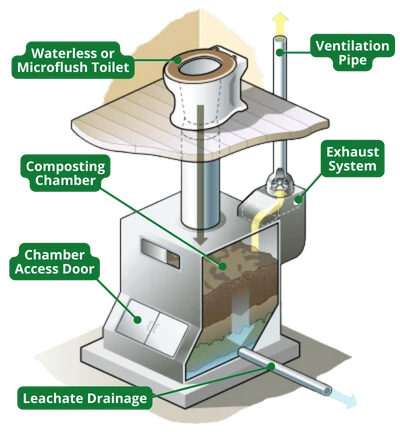
Composting toilets are at the forefront of eco-friendly living, transforming human waste into compost, a critical process in sustainable waste management systems. This method not only recycles solid waste but also enriches the soil with vital nutrients, making it a perfect match for tiny house dwellers, RV enthusiasts, and those in off-grid cabins seeking alternative toilet solutions.
Types of Composting Toilet Systems
- Natural Systems: These leverage passive composting, utilizing carbon-rich materials like peat moss, sawdust, or coconut coir. They excel in absorbing liquid waste, reducing unpleasant odors, and fostering an optimal composting environment. Proper ventilation plays a crucial role, ensuring efficient moisture control and oxygenation of the compost.
- Active Systems: By incorporating electric fans and heaters, these systems boost the composting process through enhanced ventilation and accelerated decomposition. Features like mixing mechanisms distribute moisture and aerate the compost, offering a harmonious blend of convenience and environmental benefits.
Enhancing the Process
Urine diversion, a key feature, separates liquid waste from solids, maintaining the balance essential for effective composting and preventing the compost from becoming too moist, which could slow down the process and create odors.
Environmental and Practical Benefits
- Water Conservation: Operating as a waterless toilet, composting toilets drastically cut down water usage, supporting water conservation efforts and leading to significant savings on water bills.
- Low Maintenance: These systems boast low maintenance, requiring just the addition of bulking agents and occasional removal of compost, streamlining waste management.
- Nutrient Recycling: The compost produced contributes to a circular economy, transforming waste into a valuable resource for gardening, diminishing the need for chemical fertilizers.
- Eco-friendly Impact: By avoiding traditional septic systems and reducing water consumption, composting toilets underscore their role in sustainable living practices, positioning themselves as the best choice for those committed to environmental stewardship.
Composting toilets represent more than just an alternative to conventional toilets; they mark a proactive stride towards a sustainable lifestyle. Ideal for installation in tiny homes, RVs, or off-grid cabins, they epitomize water conservation, waste recycling, and a commitment to the environment. Offering a viable and impactful solution for reducing one’s ecological footprint, composting toilets align with the advancements in sustainable living technologies, making them a good option for modern eco-conscious living.
Understanding Incinerating Toilets
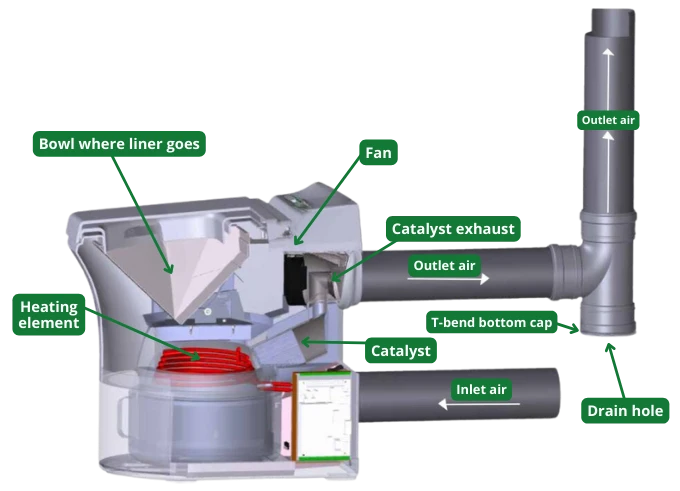
Incinerating toilets mark a significant advancement in eco-friendly waste management systems, utilizing high temperatures to convert human waste into a minimal volume of sterile ash. This high-efficiency process not only guarantees the complete incineration of solid waste but also produces odorless ash, simplifying disposal and significantly diminishing waste volume. For individuals exploring waterless toilet options for tiny homes, RVs, or off-grid cabins, incinerating toilets offer an innovative solution.
Types of Incinerating Toilets
- Electric Models: With the ease of a start button, electric incinerating toilets are a prime choice for locations with reliable electric power. These units epitomize convenience, efficiently transforming waste into ash without the need for a traditional water supply or septic system.
- Propane Gas Models: Tailored for off-grid living where electricity may not be readily available, propane gas incinerating toilets offer unparalleled versatility. Fueled by propane gas, these models adapt effortlessly to the unique demands of tiny house living, RV adventures, and cabin life, ensuring reliable waste management regardless of utility access.
Advantages of Incinerating Toilets
- Water Conservation: Operating entirely without water, these toilets are at the forefront of conservation efforts, making them particularly valuable in drought-prone areas or for anyone dedicated to reducing water consumption.
- Simplified Waste Disposal: The conversion of waste into ash eliminates the necessity for complex sewage systems, facilitating easy installation and low maintenance. This waterless urinal and toilet solution isn’t only hygienic but also eco-friendly, offering a straightforward alternative to traditional flushing toilets.
- Low Maintenance: The self-cleaning feature of the incineration chamber, combined with the absence of direct waste handling, highlights the low-maintenance advantage of incinerating toilets. This feature is particularly appealing for those seeking a hassle-free approach to sustainable living.
Adopting incinerating toilets as part of your sustainable living strategy introduces a low-maintenance, high-efficiency alternative that aligns with environmental stewardship. Whether facing the challenges of off-grid living, focusing on water conservation, or in search of a simple waste management system, incinerating toilets stand as a robust choice. They merge convenience with environmental benefits, positioning themselves as an excellent option for modern, sustainable living in tiny homes, RVs, and remote cabins.
Comparative Analysis
Diving into a detailed comparison between composting toilets and incinerating toilets reveals significant distinctions, advantages, and cost implications, guiding you toward an informed decision that aligns with your sustainable living goals and environmental priorities.
Electricity and Water Requirements
- Composting Toilets: Excel in water conservation, operating without any water usage. Certain models might require a minimal amount of electricity, ideally suited for solar-powered homes, tiny homes, and off-grid living scenarios, emphasizing their role in eco-friendly living.
- Incinerating Toilets: Electric models necessitate a continuous electric power supply, while propane versions offer independence from electricity, making them perfect for remote or off-grid dwellings. Their waterless operation underscores the commitment to reducing water consumption.
Maintenance
- Composting Toilets: Necessitate the addition of peat moss or other bulking agents, coupled with periodic compost emptying. This eco-conscious routine demands engagement, but rewards users with a direct contribution to sustainability.
- Incinerating Toilets: Boil down maintenance to ash removal, offering a cleaner experience without the complexities of direct waste handling, presenting a low-maintenance solution for waste management.
Installation
- Composting Toilets: Their installation versatility makes them an adaptable choice across a variety of settings, from tiny house configurations to RVs, without the need for complex plumbing.
- Incinerating Toilets: Require venting for exhaust gases, and electric units might need specific power connections, potentially complicating setup in some locations.
Cleanliness and Odor Control
- Composting Toilets: With proper upkeep, remain odor-free, ensuring a clean bathroom environment.
- Incinerating Toilets: Their high-temperature incineration process is virtually an odorless operation, enhancing hygiene and user comfort.
Ecological Impact
- Composting Toilets: Stand out for their ability to recycle waste into compost, significantly conserving water and endorsing a zero-waste lifestyle, making them a cornerstone of environmental stewardship.
- Incinerating Toilets: Although they require energy to operate, their waterless design plays a critical role in water conservation efforts, crucial for those dedicated to minimizing environmental impact.
Cost
- Composting Toilets: Offer an economically sustainable option over the long term, with low operational costs thanks to their minimal water and electricity usage.
- Incinerating Toilets: While possibly higher in initial and running costs, particularly for propane gas models, they afford savings in water usage and simpler waste disposal, aligning with cost-effective waste management practices. On average, depending on the model, you’ll get 75 to 100 incineration cycles from a single 20lb bottle of propane.
In reality, whether you lean towards a composting toilet system for its deep-rooted sustainability and water conservation benefits, ideal for tiny homes, RVs, or off-grid living, or prefer the convenience and cleanliness of an incinerating toilet, your decision should mirror your lifestyle, practical needs, and commitment to reducing your ecological footprint. Each system brings distinct advantages to the table, empowering you to choose a path that best suits your journey toward sustainable living.
The Comparison Chart
Feature
Composting Toilets
Incinerating Toilets
Waste Handling
Decompose waste into compost
Burn waste into ash
Water Usage
Zero water use, excellent for conservation
Zero water use, supports water conservation
Safety
Safe with proper use and maintenance
Safe with safety features for the incineration process
Maintenance Frequency
Monthly to every few months for solids; more frequent for liquids
Ash disposal as needed, less frequent than composting
Odor Control
Odor-free with proper ventilation and maintenance
Typically odorless due to high-temperature combustion
Energy Requirements
Minimal electricity for some models, often optional
Requires consistent electricity or propane supply
Suitability for Small Spaces
Ideal for tiny homes and RVs
Suitable for tiny homes and RVs, requires venting
End Product Usage
Compost can fertilize non-edible plants
Ash must be disposed of, cannot be reused
Cost
Lower initial cost, minimal ongoing expenses
Higher initial and ongoing costs
Choosing Factors
Prioritize sustainability, water conservation
Favor convenience, ease of use, minimal maintenance
You’re seeing this box because you’re on your mobile phone right now. Hello! Unfortunately, mobile devices don’t like complicated (albeit helpful) charts and tables on a page. But, we don’t want you to miss out, so we created this easy infographic you can download, or enlarge, instead.
User Experience and Practical Considerations
Navigating the integration of composting and incinerating toilets into diverse living spaces such as tiny homes, RVs, and off-grid cabins underscores their versatility and alignment with sustainable living practices. These alternative toilet systems are tailored to meet the unique demands of compact living, offering solutions that prioritize eco-friendliness, space efficiency, and maintenance ease.
Tiny Home Living
In the realm of tiny house living, where every square foot matters, families dedicated to reducing their environmental impact find a perfect ally in composting toilets. These units not only champion water conservation by eliminating the need for gallons of water per flush but also support sustainable living through the recycling of human waste into compost. The low maintenance nature of these toilets, requiring additions of peat moss, sawdust, or coconut coir, seamlessly blends into a lifestyle that values green practices.
Off-Grid Cabin Retreats
For couples seeking solace in off-grid cabin retreats, the propane incinerating toilet emerges as a standout waterless toilet solution. Freed from the constraints of traditional utility access, this fuel-burning model efficiently manages waste by converting it into a small amount of ash, epitomizing the essence of off-grid living. Its easy installation and virtually zero maintenance requirements underscore the appeal of incinerating toilets for remote living.
Practical Considerations
- Installation Ease: Composting toilets are lauded for their DIY-friendly installation, ideal for those outfitting tiny homes or RVs. Conversely, incinerating toilets may necessitate additional steps for venting and power connections, catering to those who prioritize ease of use over installation simplicity.
- Space Requirements: The need for storage of bulking agents in composting systems contrasts with the compact, self-contained design of incinerating toilets, which is particularly advantageous in space-limited settings.
- Maintenance Frequency: Incinerating toilets distinguish themselves with low maintenance, mainly focused on ash removal, offering a cleaner and simpler upkeep compared to the composting process, which demands regular material addition and compost handling.
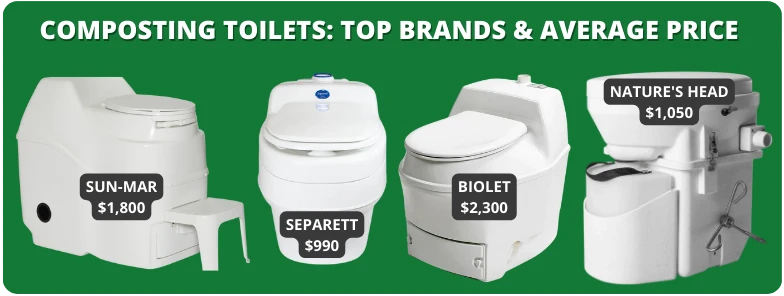
Choosing between a composting and incinerating toilet depends on individual lifestyle, environmental considerations, and practical requirements. Each system enriches the living experience, marrying the principles of sustainability, water conservation, and waste management efficiency. Whether for a tiny home, RV, or cabin, making an informed decision ensures alignment with your sustainable living journey, enhancing both environmental benefits and living convenience in every unique scenario.
Ecological and Economic Impacts
Selecting between composting and incinerating toilets involves weighing their impact on both the environment and your finances. Here’s an in-depth analysis of their environmental benefits and economic implications, vital for anyone considering alternative toilet options for sustainable living.
Environmental Benefits and Drawbacks
Composting Toilets
- Water Conservation: Excel in saving water, crucial for water conservation efforts, by operating without it, thus easing the strain on septic systems and water treatment facilities.
- Carbon Footprint: They’re energy-efficient, often powered by solar panels or requiring minimal electric power, which significantly lowers carbon dioxide emissions associated with waste management.
- Nutrient Recycling: Excel at converting human waste into compost, enriching soil without the environmental hazards linked to chemical fertilizers, promoting a zero-water and circular economy approach.
Incinerating Toilets
- Water Conservation: Share the waterless benefit with composting models, ideal for drought-prone regions or as part of a broader water conservation strategy.
- Carbon Footprint: Tend to have a higher carbon footprint due to the natural gas or propane gas needed for the incineration process, potentially increasing greenhouse gas emissions.
- Nutrient Recycling: Offer no nutrient recycling since they transform waste into sterile ash rather than compost, a potential downside for those prioritizing full sustainability.
Economic Impacts
Composting Toilets
- Initial Costs: Range from moderate to high, though DIY composting toilet systems can mitigate expenses, appealing to those looking to customize their tiny home or off-grid setups.
- Ongoing Expenses: Are lower, thanks to minimal water usage and electricity consumption. The cost of bulking materials like peat moss or sawdust is relatively low, making them a cost-effective waste management system over time.
Incinerating Toilets
- Initial Costs: Typically higher, reflecting the sophisticated technology and materials required for safe incineration.
- Ongoing Expenses: Exceed those of composting toilets, particularly for electric incinerating toilets, which can impact your electric bill. Propane versions necessitate regular propane gas purchases, and maintenance might include replacing incineration chamber components.
In conclusion, composting toilets emerge as the more environmentally friendly and economically sustainable option, aligning with sustainable living values and reducing water and electricity usage. They’re especially suitable for eco-conscious individuals in tiny homes, RVs, or cabins.
Incinerating toilets, while offering ease of use and low maintenance, come with higher initial and operational costs, positioned for those valuing convenience and a waterless solution. Balancing sustainability with practical and economic considerations is key to choosing the system that best fits your lifestyle and environmental impact goals.
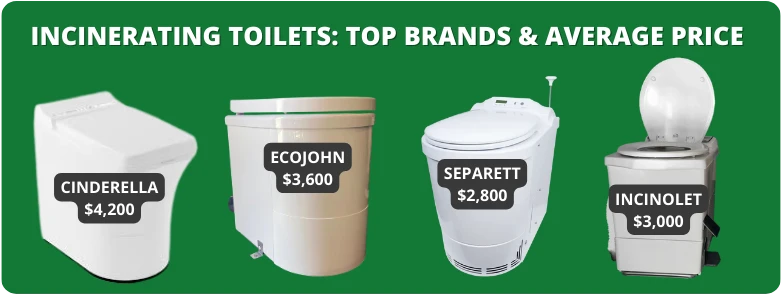
Making the Right Choice
Consider Your Living Situation
Off-Grid Living
For those distanced from traditional utilities or living a nomadic life in an RV or tiny home, each toilet system offers unique advantages. Propane incinerating toilets provide independence and ease, particularly where electric power is limited, making them suitable for mobile lifestyles. Composting toilets, on the other hand, are the go-to for sustainable living, thriving in stationary off-grid settings by promoting water conservation and nutrient recycling.
Ecological Impact
If your goal is to significantly reduce your environmental footprint, composting toilets take the lead. They excel in conserving water and turning waste into valuable compost, operating efficiently with minimal energy consumption. For those prioritizing water conservation but desiring convenience, incinerating toilets emerge as a practical alternative.
Ease of Maintenance
Seeking low maintenance? Incinerating toilets simplify upkeep by reducing waste to ash with minimal intervention. While composting toilets demand more engagement, particularly in managing the composting process, they offer a rewarding experience for those willing to invest the effort.
Evaluate Your Preferences and Needs
- Budget Considerations: The cost difference between composting and incinerating systems can be significant, from initial investment to ongoing expenses. Consider both the purchase price and the operational costs, keeping in mind long-term maintenance and energy or fuel requirements.
- Space and Installation Requirements: Assess the space you have available and the installation effort you’re prepared to undertake. Composting toilets might need additional room for composting materials, while incinerating toilets require venting and access to electricity or propane.
- Environmental Priorities: What’s most important to you in terms of environmental stewardship? Whether it’s water conservation, minimizing carbon emissions, or recycling waste, your priorities will steer you toward the system that best matches your sustainability goals.
Dedicate time to research and reflect on how each system integrates into your daily life and the larger environmental impact. Whether you gravitate towards a composting toilet for its eco-friendly benefits or an incinerating toilet for its cleanliness and convenience, it’s crucial that your choice bolsters your lifestyle, values, and planetary well-being.
Ultimately, the ideal toilet system for you is one that fulfills your needs, aligns with your environmental ethos, and suits your living situation. By thoughtfully considering these aspects, you’re equipped to make a decision that fosters a more sustainable and comfortable living environment.
FAQ: Composting Toilets vs. Incinerating Toilets
What are the main differences between compost toilets and traditional flushing toilets?
Compost toilets operate without water, transforming human waste into compost, a stark contrast to traditional flushing toilets that use much water per flush. While composting toilets prioritize sustainability and water conservation, conventional toilets are more about convenience and familiarity, often requiring a septic tank or sewer system.
Can incinerating toilets be used in off-grid settings?
Absolutely. Incinerating toilets, particularly propane versions and electric models designed for solar power, are perfect for off-grid living. They don’t rely on a septic system, making them ideal for remote locations where conventional utilities are inaccessible.
How does the incineration cycle in toilets benefit RV users?
The incineration cycle in toilets offers RV users a waterless solution, eliminating the need for a black water tank. This high-efficiency toilet system reduces waste to ash, simplifying maintenance and freeing up space traditionally used for holding tanks.
Are there eco-friendly options for construction sites?
Yes, dry flush toilets and waterless urinals present eco-friendly options for construction sites, providing sanitation without the need for water supply. These self-contained units offer flexibility and low maintenance, ideal for temporary setups.
What safety features do electric incineration toilets have?
Electric incineration toilets come with several safety features, including automatic shut-off, temperature controls, and exhaust vents to manage combustion gases, ensuring safe and effective operation.
How do urine-diverting toilets enhance the composting process?
Urine-diverting toilets separate liquid waste from solid waste, improving the composting process by controlling moisture levels. This separation facilitates more efficient anaerobic digestion and reduces unpleasant odors.
Can composting toilets be used regularly in a family home?
Yes, composting toilets are designed for regular use in a family home. They are high-efficiency toilets that handle daily waste, turning it into compost with regular maintenance and bulking materials like sawdust or peat moss.
What are the benefits of a stainless steel bowl in a toilet?
A stainless steel bowl in a toilet offers durability, ease of cleaning, and resistance to corrosion and stains, making it a good choice for both composting and incinerating toilets.
How do local regulations affect the installation of alternative toilets?
Local regulations can significantly impact the installation of alternative toilets, including composting and incinerating models. It’s essential to conduct a little research on zoning laws and health codes to ensure compliance, especially for systems like onlot sewage systems or waterless urinals.
What should I consider when choosing between a compost toilet and an electric incinerating toilet for my tiny home?
Consider space requirements, environmental impact, energy usage (if opting for an electric model), and maintenance needs. Compost toilets are great for zero water usage and nutrient recycling, while electric incinerating toilets offer simplicity and ease of use with a safety feature for health hazards management.
No Right or Wrong Answer!
There’s no one-size-fits-all answer when it comes to selecting the right alternative toilet system—be it a composting toilet or an electric incinerating toilet. This journey through the various types of toilets has illuminated the significant differences in how they manage waste, their demands on water and energy, as well as their installation and maintenance nuances, not to forget the broader ecological and economic impacts.
Composting toilets stand out as beacons of sustainability, transforming human waste into compost and championing water conservation. Ideal for those entrenched in a sustainable lifestyle, these systems resonate with anyone ready to actively participate in the composting process. They represent the best solution for tiny homes, RVs, and even remote cabins, underscoring a commitment to environmental stewardship.
Conversely, incinerating toilets, including propane versions and those powered by electric elements, redefine convenience and hygiene. With minimal maintenance requirements—think simple ash removal via a hand crank and no need for a black tank or holding tank—they’re especially appealing for those seeking ease of use. The electric incinerator toilet models, equipped with safety features like exhaust vents to manage combustion gases, offer a hygienic experience by eliminating contact with waste.
More To Discover
- 9 Expert-Recommended Features for Your Eco-Friendly Dream Home
- Wood Dust Solution Traps up to 99.9% of Microplastics in Water, A Potential Game-Changer Against Pollution
- Shein Resale: Greenwashing Disguised as Sustainability While They Grab Your Data
- Enviva’s Wood Pellet Plant in Georgia, the World’s Largest, Is Exceeding Pollution Limits According To State
Your decision should mirror your environmental values, lifestyle preferences, and the specifics of your living situation. Whether opting for a traditional flushing toilet with a foot pedal for water efficiency or exploring fuel-burning models for off-the-grid setups, the key is to find a system that enhances your life while being kind to the Earth.
As you delve into further research, weigh the entire process—from installation to daily use—against the backdrop of environmental implications and personal convenience. Choosing between a composting toilet system and an incinerating toilet isn’t merely about picking a product; it’s about embracing a pathway to a more sustainable, conscientious lifestyle. Ultimately, the best models are those that not only meet your practical needs but also resonate with your dedication to preserving our planet.
In the quest for a sustainable toilet solution, whether it’s the nature’s head of composting or the clean efficiency of incineration, remember that the optimal choice is the one that aligns with your sustainability goals and daily living requirements, ensuring a comfortable, responsible, and eco-friendly home environment.












